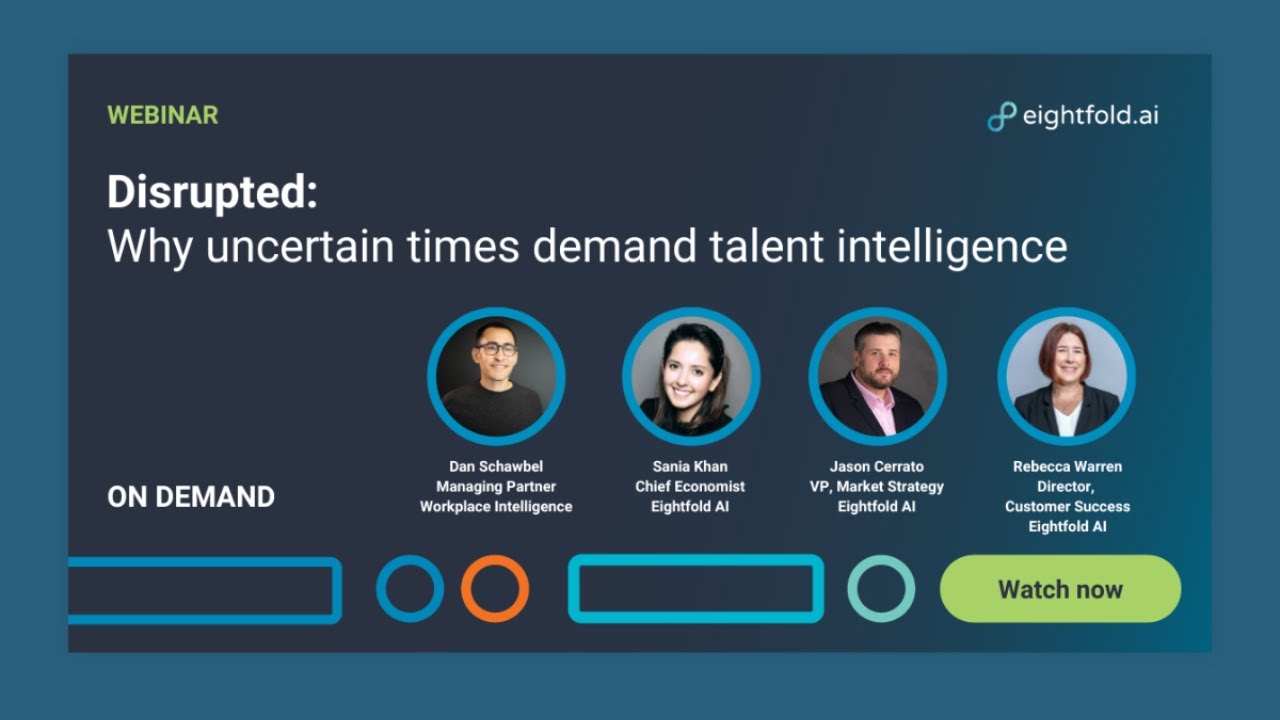- Expecting the unexpected — and quickly and intelligently responding — is now part of your job as a talent professional.
- Major disruptions or global factors are impossible to predict, but you can help prepare your organization for uncertainty with the right talent at the right time.
- With AI and talent intelligence, you can understand your employees’ skills and what skills are needed to create and maintain a highly agile workforce.
Managing uncertainty is an essential part of your job as a talent professional. The difference to how well you weather any disruption is how quickly and intelligently you respond to inevitable market shifts.
As many C-suite leaders prepare for what’s ahead, it’s up to your talent team to anticipate course changes with the right talent at the right time to support the organization’s goals.
Recently, we discussed the current climate with future of work expert Dan Schawbel. We talked about how organizations can get ahead by taking a skills-based approach using talent intelligence to become more agile and resilient in the face of great change.
Here are a few of the biggest factors influencing the job market right now, according to our panel.

Related content: Watch the entire conversation with Dan Schawbel and our Eightfold panel on “Disrupted: Why uncertain times demand talent intelligence.”
Current talent challenges continue
Emerging from the pandemic, organizations are often managing hybrid and remote workforces. This presents challenges with communication and collaboration, especially ensuring that remote workers stay engaged.
“The opportunity for organizations with more flexible work means access to a bigger talent pool,” Schawbel said. “There’s also cost savings as the office footprint is declining. But the challenge still remains in creating policies, procedures, and best practices for building company culture and collaboration with distributed teams.”
While executives want more workers in-house to build company culture, harness teamwork, and collaborate, employees want more flexibility. According to the Pew Research Center, approximately a third of employed adults in the U.S. work from home.
Their employers, however, have a different opinion of remote work. A recent survey of 1,000 corporate decision-makers found that 90% of companies with office space will have a return-to-office policy in place this year.
Organizational and talent leaders are still determining the best balance between remote, hybrid, and in-person work environments, but the right mix to create a fully functioning team is still a mystery to most.
Using data to anticipate the future
It’s never been more critical to correctly use clean data to navigate future uncertainty.
“If you think about it, for the last two decades, we’ve been collecting data about how things get done,” said Sania Khan, Eightfold Chief Economist. “Organizations have this massive trove of data, and now with AI, they can actually use all that data.”
While major disruptions like natural disasters, pandemics, wars, and other global factors can be impossible to predict, you can control the data and insights you use to inform your entire organization’s talent strategy.
Tapping into data on recruiting, development, and talent management can provide real-time recommendations at scale. This is something we’ve never been able to do before, but with AI it’s now possible. HR can use data to help predict turnover, employee engagement, and performance.
The real power of data comes when you look at organizational talent through the lens of skills. Schawbel says the biggest skill organizations are looking for is adaptability.
“In 2014, I did studies on what managers were looking for, and adaptability was at the bottom,” he said. “Now adaptability is at the top because organizations are looking to create a fluid workforce that is highly adaptable to change.”
Strategies for putting the right people in the right places
Agility is doing things faster, but it’s also the ability to quickly change direction. The best strategy to improve agility is to understand your workforce’s skills and what skills you need to reach overall business objectives.
Skills give you the granularity to understand the work at hand, and the capability of your talent to do that work. Jason Cerrato, VP, Market Strategy at Eightfold, says that traditional organizational charts and job roles don’t allow for agility.
“When you’re planning for roles that you may not even know what they are yet, you need to look cross-functionally,” Cerrato said. “Looking vertically down a traditional organization chart within each function doesn’t give you a view into adjacent skills. The new roles AI will create with job titles we’ve never seen before are increasingly hybrid in terms of skills needed. They bridge skills in operations, finance, customer success, and this kind of talent may not be easy to source.”
Becoming a skills-based organization is a challenge unto itself even though it’s a fantastic strategy for weathering change.
Khan cited publishing’s move from print to digital as a prime example. When the publishing industry was faced with this major disruption, many only had talent who knew nothing about this new digital world. When it came time to shift to digital, instead of teaching their people new digital skills, they let many of them go and rehired talent with digital skills. Part of why this happened is because leadership didn’t know what skills were needed and how this impacted business goals.
“We don’t want to do that across industries as we’re looking at a major shift here with AI,” Khan said. “We have to learn from our mistakes. We’re at a point where we can use talent intelligence to identify the declining tasks and skills as well as the rising tasks and skills of the future.
“Using that intelligence, we can look at how to bridge the gap between the two, whether it’s upskilling or reskilling,” she continued. “We can look at what options talent has for future roles that reach company objectives instead of doing layoffs and trying to hire hard-to-find talent with those potential skills.”
AI’s impact on the employee experience
We’re currently facing an age where every industry is changing fast and labor shortages are making it harder to find the right talent with the right skills. Retaining top talent is an objective for most organizations.
In any work culture — especially a hybrid or remote one — using AI-based technologies to help support employee experience can ensure that you’re attracting and keeping the right talent.
This new way of working demands that you design work around the talent and skills you have — not try to find the perfect match for a job or role. Mapping skills to jobs is just one part of the picture. Organizations also need to map skills to people in the context of the work that needs to be done.
With talent intelligence, you can understand what’s happening with your talent and their work in real time — and also see where they are taking that job. This dynamic system benefits both employees and the organization by providing personalized career opportunities, enhanced transparency, and better retention.
Talent intelligence can foster a culture of continuous learning and development, with a focus on individualized micro-development plans based on skills rather than broad yearly reviews. Ultimately, this technology provides for a deeper understanding of talent through a more personalized lens, shaping the future of talent management and how we weather change.
Watch our full webinar with Dan Schawbel, Managing Partner for Workplace Intelligence, “Disrupted: Why uncertain times demand talent intelligence,” on demand now.
Rebecca Warren is Director, Customer Success, at Eightfold AI.










